Report on Budget Analysis, Capital Budgeting, and Recommendations
VerifiedAdded on 2022/07/27
|7
|1108
|14
Report
AI Summary
This report analyzes the purpose, benefits, and fundamental components of budgeting, focusing on revenue and capital budgets. It delves into capital budgeting processes, including project recognition, screening, selection, implementation, and performance review. The report evaluates capital investment projects using methods such as the Payback Period, Net Present Value (NPV), and Internal Rate of Return (IRR), detailing the advantages and limitations of each. It then recommends that the company XYZ Limited adopt budgeting to facilitate financial decision-making and achieve its business goals. The report emphasizes the importance of early annual budgeting for a complete fiscal year estimate and includes a bibliography of relevant sources.
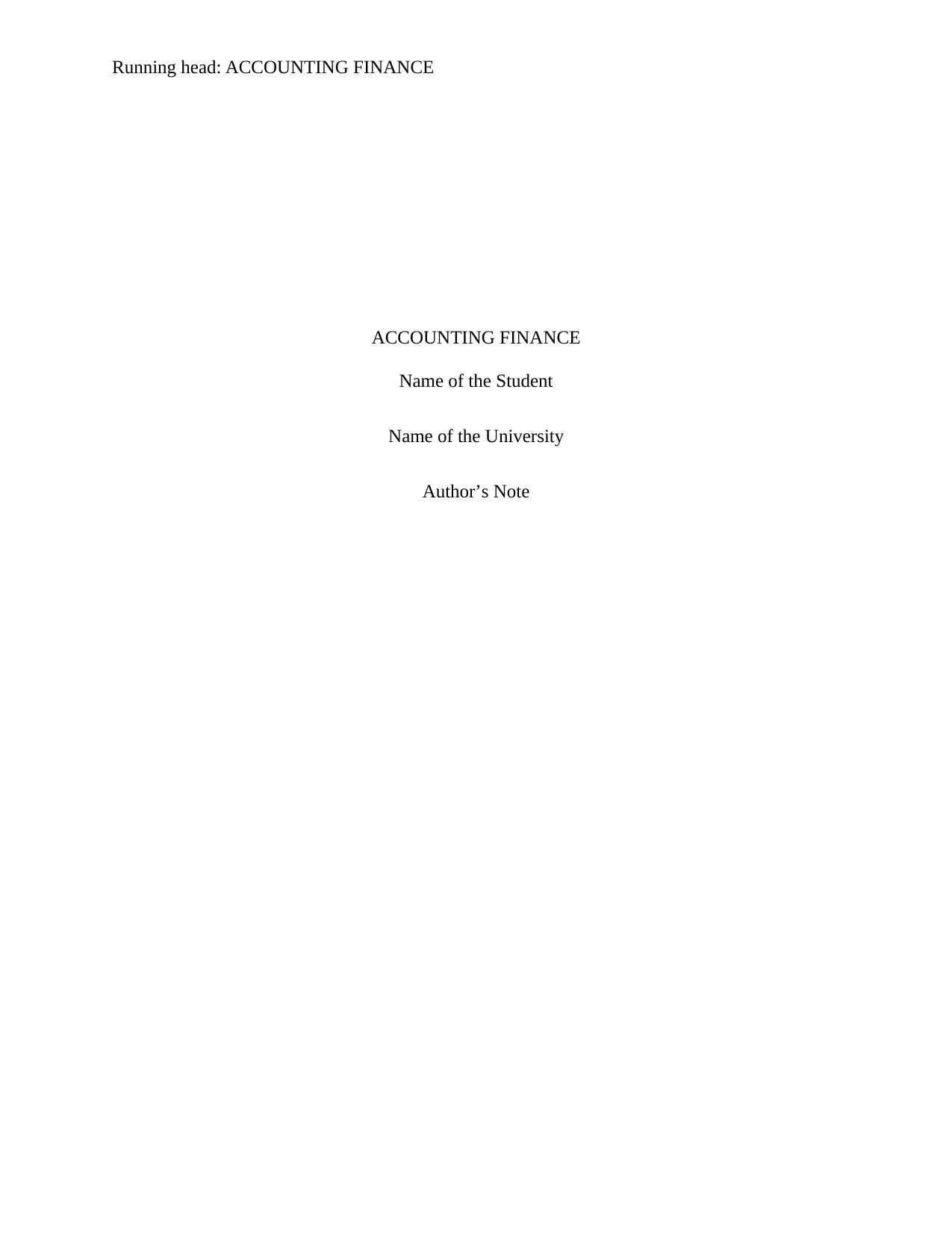
Running head: ACCOUNTING FINANCE
ACCOUNTING FINANCE
Name of the Student
Name of the University
Author’s Note
ACCOUNTING FINANCE
Name of the Student
Name of the University
Author’s Note
Paraphrase This Document
Need a fresh take? Get an instant paraphrase of this document with our AI Paraphraser
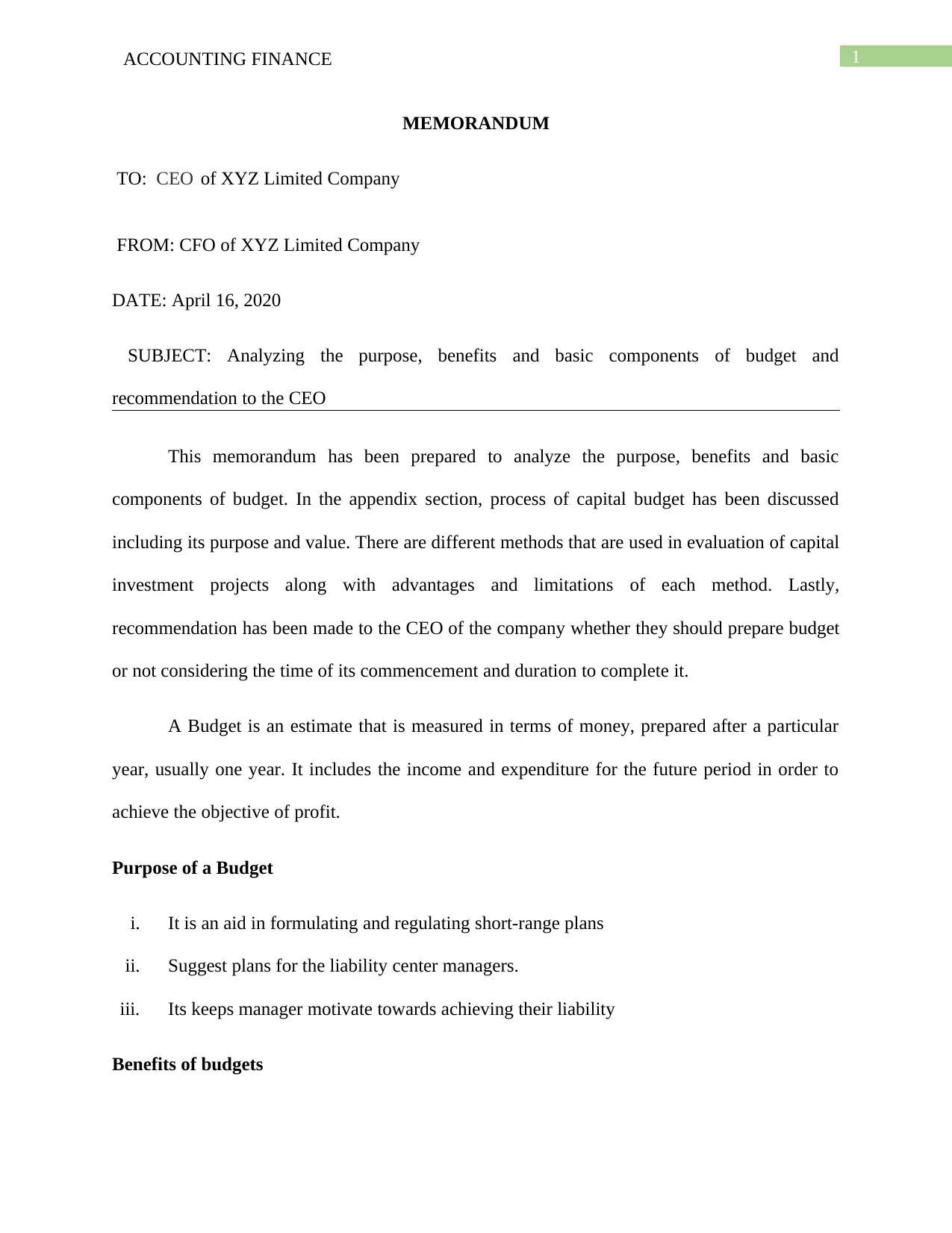
1ACCOUNTING FINANCE
MEMORANDUM
TO: CEO of XYZ Limited Company
FROM: CFO of XYZ Limited Company
DATE: April 16, 2020
SUBJECT: Analyzing the purpose, benefits and basic components of budget and
recommendation to the CEO
This memorandum has been prepared to analyze the purpose, benefits and basic
components of budget. In the appendix section, process of capital budget has been discussed
including its purpose and value. There are different methods that are used in evaluation of capital
investment projects along with advantages and limitations of each method. Lastly,
recommendation has been made to the CEO of the company whether they should prepare budget
or not considering the time of its commencement and duration to complete it.
A Budget is an estimate that is measured in terms of money, prepared after a particular
year, usually one year. It includes the income and expenditure for the future period in order to
achieve the objective of profit.
Purpose of a Budget
i. It is an aid in formulating and regulating short-range plans
ii. Suggest plans for the liability center managers.
iii. Its keeps manager motivate towards achieving their liability
Benefits of budgets
MEMORANDUM
TO: CEO of XYZ Limited Company
FROM: CFO of XYZ Limited Company
DATE: April 16, 2020
SUBJECT: Analyzing the purpose, benefits and basic components of budget and
recommendation to the CEO
This memorandum has been prepared to analyze the purpose, benefits and basic
components of budget. In the appendix section, process of capital budget has been discussed
including its purpose and value. There are different methods that are used in evaluation of capital
investment projects along with advantages and limitations of each method. Lastly,
recommendation has been made to the CEO of the company whether they should prepare budget
or not considering the time of its commencement and duration to complete it.
A Budget is an estimate that is measured in terms of money, prepared after a particular
year, usually one year. It includes the income and expenditure for the future period in order to
achieve the objective of profit.
Purpose of a Budget
i. It is an aid in formulating and regulating short-range plans
ii. Suggest plans for the liability center managers.
iii. Its keeps manager motivate towards achieving their liability
Benefits of budgets
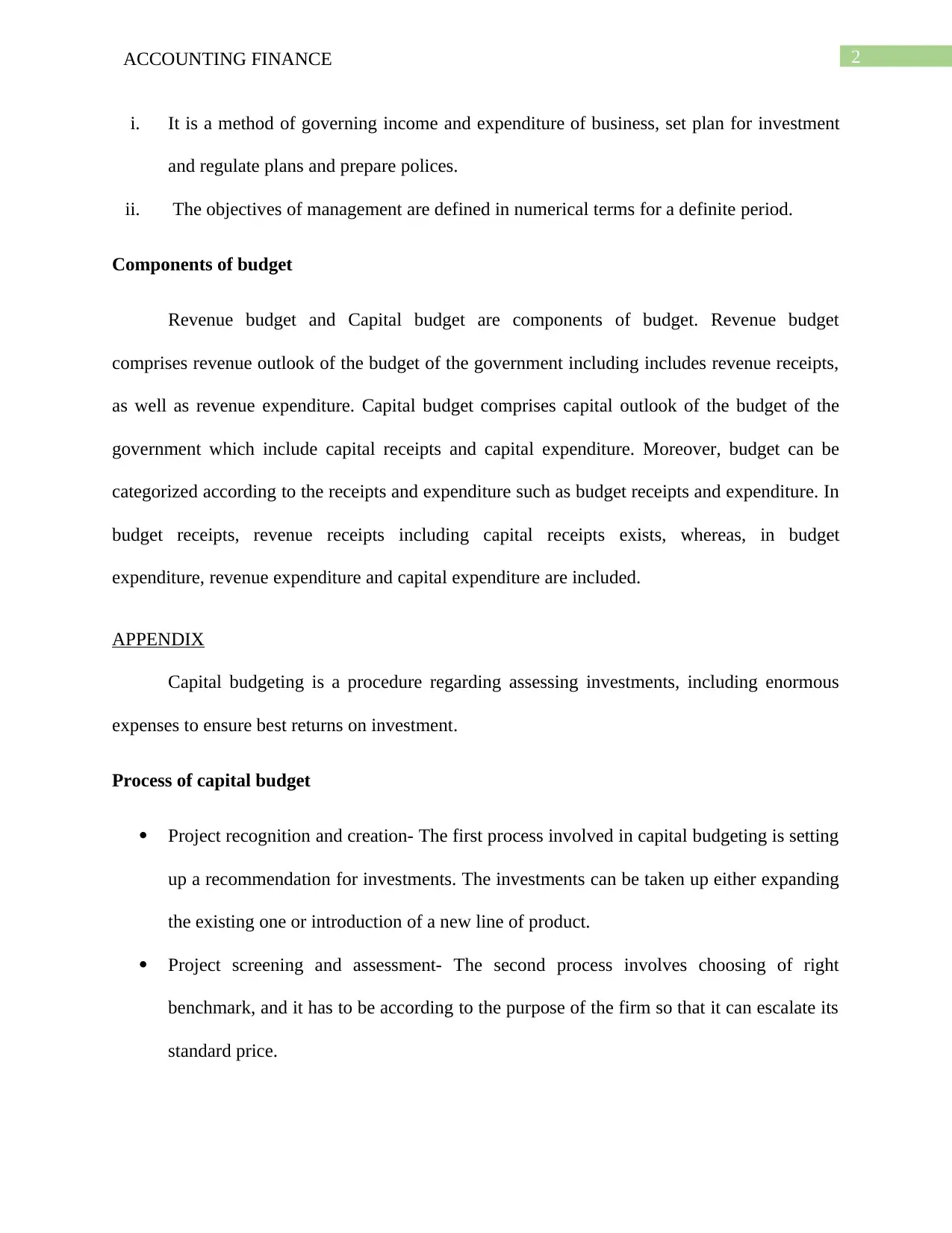
2ACCOUNTING FINANCE
i. It is a method of governing income and expenditure of business, set plan for investment
and regulate plans and prepare polices.
ii. The objectives of management are defined in numerical terms for a definite period.
Components of budget
Revenue budget and Capital budget are components of budget. Revenue budget
comprises revenue outlook of the budget of the government including includes revenue receipts,
as well as revenue expenditure. Capital budget comprises capital outlook of the budget of the
government which include capital receipts and capital expenditure. Moreover, budget can be
categorized according to the receipts and expenditure such as budget receipts and expenditure. In
budget receipts, revenue receipts including capital receipts exists, whereas, in budget
expenditure, revenue expenditure and capital expenditure are included.
APPENDIX
Capital budgeting is a procedure regarding assessing investments, including enormous
expenses to ensure best returns on investment.
Process of capital budget
Project recognition and creation- The first process involved in capital budgeting is setting
up a recommendation for investments. The investments can be taken up either expanding
the existing one or introduction of a new line of product.
Project screening and assessment- The second process involves choosing of right
benchmark, and it has to be according to the purpose of the firm so that it can escalate its
standard price.
i. It is a method of governing income and expenditure of business, set plan for investment
and regulate plans and prepare polices.
ii. The objectives of management are defined in numerical terms for a definite period.
Components of budget
Revenue budget and Capital budget are components of budget. Revenue budget
comprises revenue outlook of the budget of the government including includes revenue receipts,
as well as revenue expenditure. Capital budget comprises capital outlook of the budget of the
government which include capital receipts and capital expenditure. Moreover, budget can be
categorized according to the receipts and expenditure such as budget receipts and expenditure. In
budget receipts, revenue receipts including capital receipts exists, whereas, in budget
expenditure, revenue expenditure and capital expenditure are included.
APPENDIX
Capital budgeting is a procedure regarding assessing investments, including enormous
expenses to ensure best returns on investment.
Process of capital budget
Project recognition and creation- The first process involved in capital budgeting is setting
up a recommendation for investments. The investments can be taken up either expanding
the existing one or introduction of a new line of product.
Project screening and assessment- The second process involves choosing of right
benchmark, and it has to be according to the purpose of the firm so that it can escalate its
standard price.
⊘ This is a preview!⊘
Do you want full access?
Subscribe today to unlock all pages.

Trusted by 1+ million students worldwide
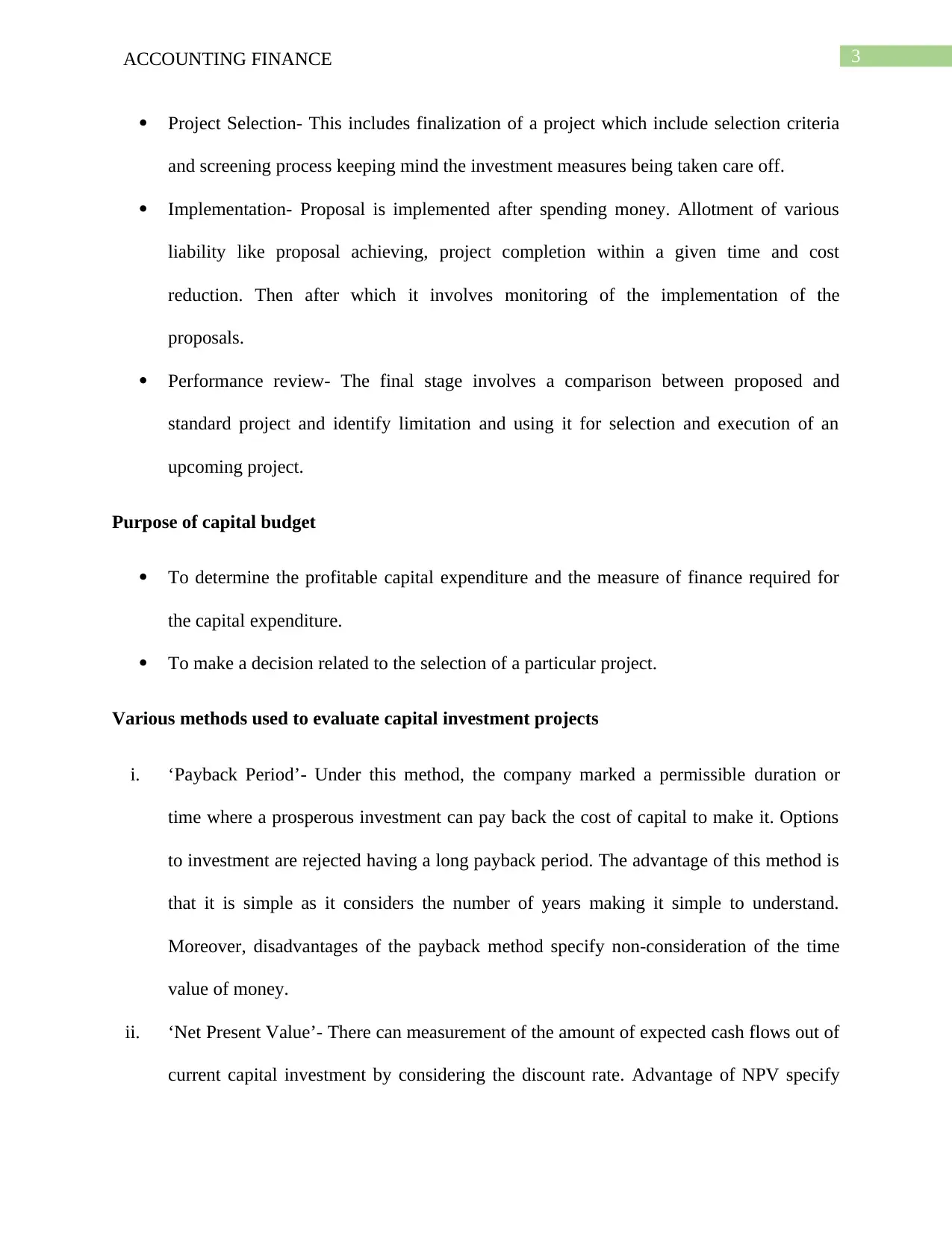
3ACCOUNTING FINANCE
Project Selection- This includes finalization of a project which include selection criteria
and screening process keeping mind the investment measures being taken care off.
Implementation- Proposal is implemented after spending money. Allotment of various
liability like proposal achieving, project completion within a given time and cost
reduction. Then after which it involves monitoring of the implementation of the
proposals.
Performance review- The final stage involves a comparison between proposed and
standard project and identify limitation and using it for selection and execution of an
upcoming project.
Purpose of capital budget
To determine the profitable capital expenditure and the measure of finance required for
the capital expenditure.
To make a decision related to the selection of a particular project.
Various methods used to evaluate capital investment projects
i. ‘Payback Period’- Under this method, the company marked a permissible duration or
time where a prosperous investment can pay back the cost of capital to make it. Options
to investment are rejected having a long payback period. The advantage of this method is
that it is simple as it considers the number of years making it simple to understand.
Moreover, disadvantages of the payback method specify non-consideration of the time
value of money.
ii. ‘Net Present Value’- There can measurement of the amount of expected cash flows out of
current capital investment by considering the discount rate. Advantage of NPV specify
Project Selection- This includes finalization of a project which include selection criteria
and screening process keeping mind the investment measures being taken care off.
Implementation- Proposal is implemented after spending money. Allotment of various
liability like proposal achieving, project completion within a given time and cost
reduction. Then after which it involves monitoring of the implementation of the
proposals.
Performance review- The final stage involves a comparison between proposed and
standard project and identify limitation and using it for selection and execution of an
upcoming project.
Purpose of capital budget
To determine the profitable capital expenditure and the measure of finance required for
the capital expenditure.
To make a decision related to the selection of a particular project.
Various methods used to evaluate capital investment projects
i. ‘Payback Period’- Under this method, the company marked a permissible duration or
time where a prosperous investment can pay back the cost of capital to make it. Options
to investment are rejected having a long payback period. The advantage of this method is
that it is simple as it considers the number of years making it simple to understand.
Moreover, disadvantages of the payback method specify non-consideration of the time
value of money.
ii. ‘Net Present Value’- There can measurement of the amount of expected cash flows out of
current capital investment by considering the discount rate. Advantage of NPV specify
Paraphrase This Document
Need a fresh take? Get an instant paraphrase of this document with our AI Paraphraser
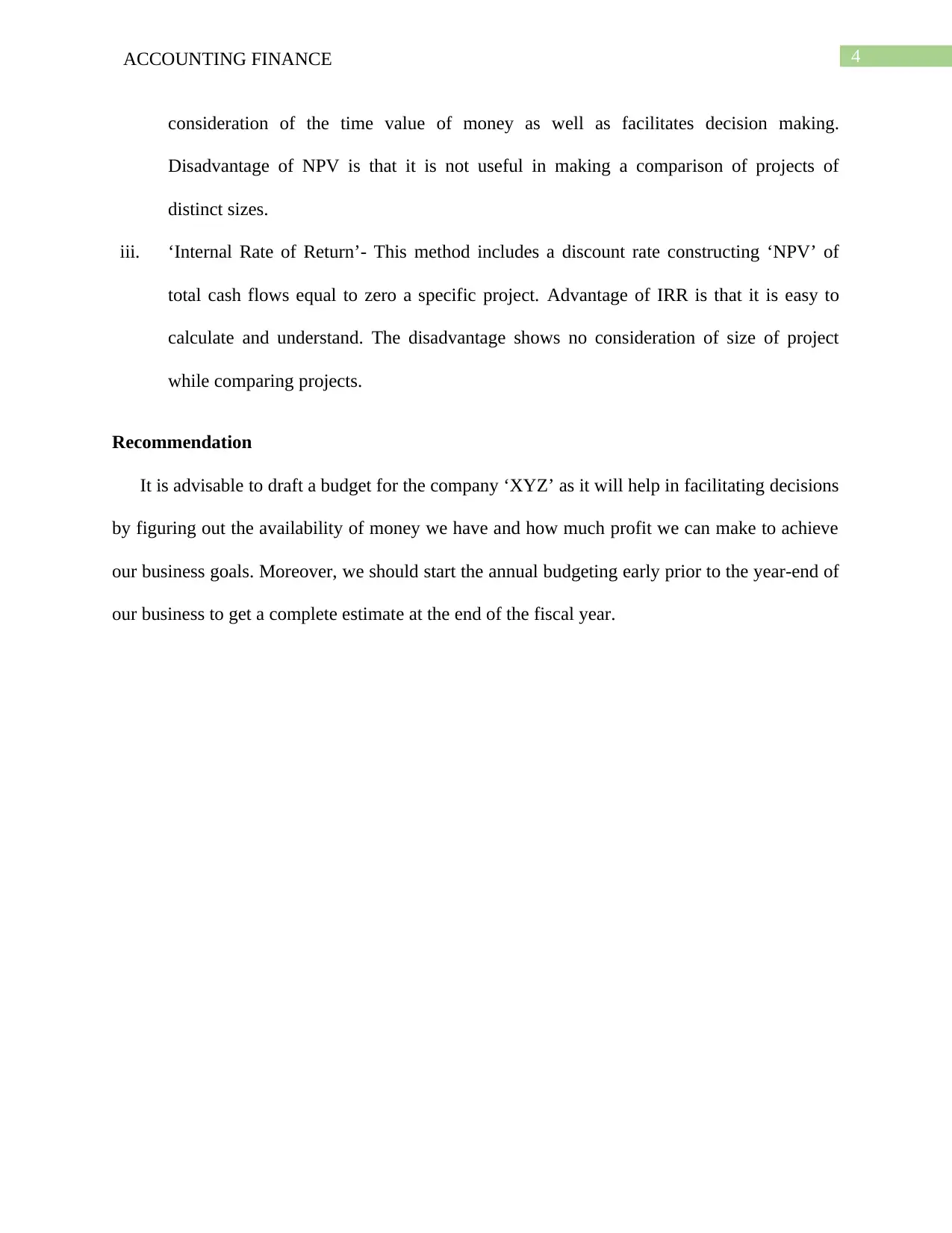
4ACCOUNTING FINANCE
consideration of the time value of money as well as facilitates decision making.
Disadvantage of NPV is that it is not useful in making a comparison of projects of
distinct sizes.
iii. ‘Internal Rate of Return’- This method includes a discount rate constructing ‘NPV’ of
total cash flows equal to zero a specific project. Advantage of IRR is that it is easy to
calculate and understand. The disadvantage shows no consideration of size of project
while comparing projects.
Recommendation
It is advisable to draft a budget for the company ‘XYZ’ as it will help in facilitating decisions
by figuring out the availability of money we have and how much profit we can make to achieve
our business goals. Moreover, we should start the annual budgeting early prior to the year-end of
our business to get a complete estimate at the end of the fiscal year.
consideration of the time value of money as well as facilitates decision making.
Disadvantage of NPV is that it is not useful in making a comparison of projects of
distinct sizes.
iii. ‘Internal Rate of Return’- This method includes a discount rate constructing ‘NPV’ of
total cash flows equal to zero a specific project. Advantage of IRR is that it is easy to
calculate and understand. The disadvantage shows no consideration of size of project
while comparing projects.
Recommendation
It is advisable to draft a budget for the company ‘XYZ’ as it will help in facilitating decisions
by figuring out the availability of money we have and how much profit we can make to achieve
our business goals. Moreover, we should start the annual budgeting early prior to the year-end of
our business to get a complete estimate at the end of the fiscal year.
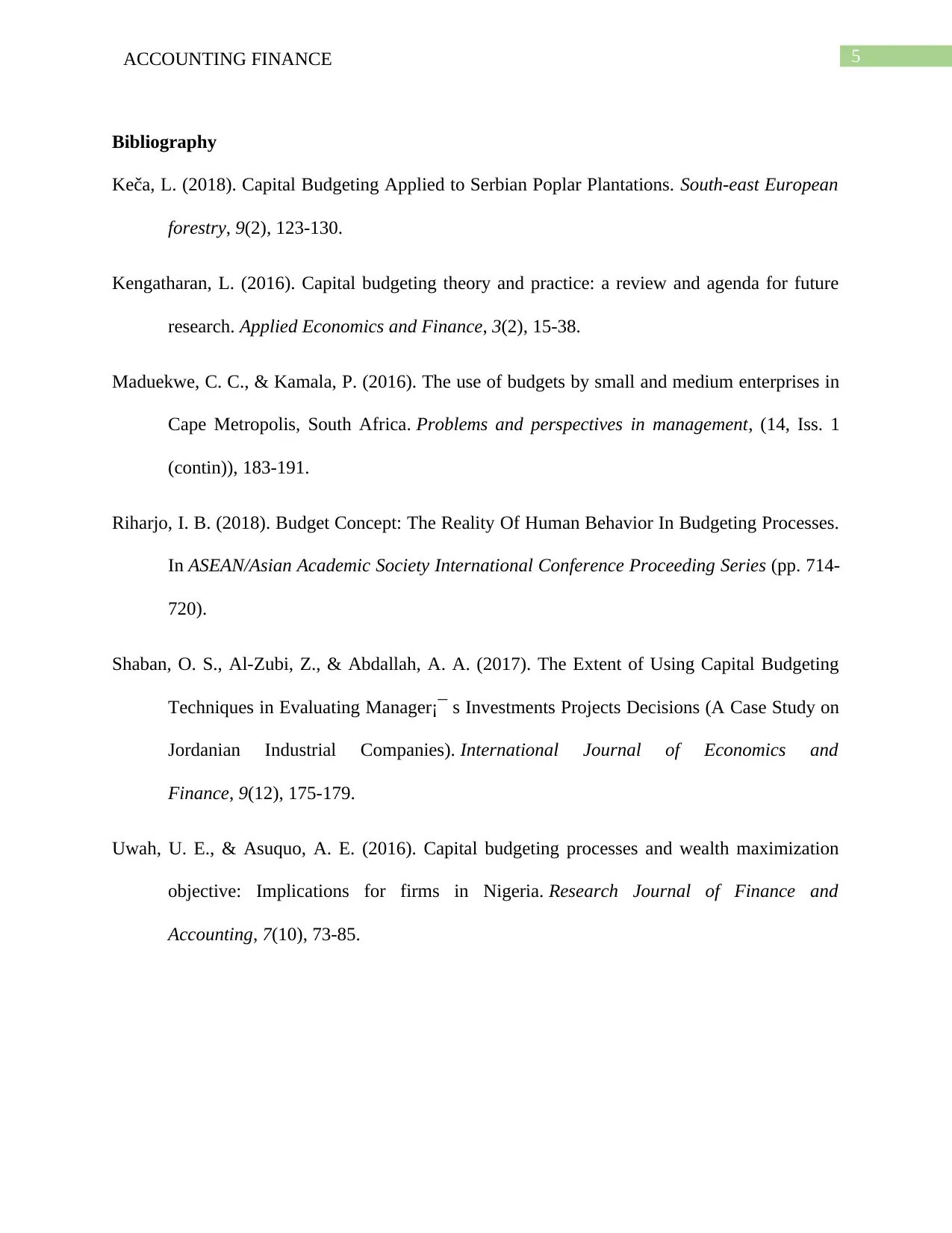
5ACCOUNTING FINANCE
Bibliography
Keča, L. (2018). Capital Budgeting Applied to Serbian Poplar Plantations. South-east European
forestry, 9(2), 123-130.
Kengatharan, L. (2016). Capital budgeting theory and practice: a review and agenda for future
research. Applied Economics and Finance, 3(2), 15-38.
Maduekwe, C. C., & Kamala, P. (2016). The use of budgets by small and medium enterprises in
Cape Metropolis, South Africa. Problems and perspectives in management, (14, Iss. 1
(contin)), 183-191.
Riharjo, I. B. (2018). Budget Concept: The Reality Of Human Behavior In Budgeting Processes.
In ASEAN/Asian Academic Society International Conference Proceeding Series (pp. 714-
720).
Shaban, O. S., Al-Zubi, Z., & Abdallah, A. A. (2017). The Extent of Using Capital Budgeting
Techniques in Evaluating Manager¡¯ s Investments Projects Decisions (A Case Study on
Jordanian Industrial Companies). International Journal of Economics and
Finance, 9(12), 175-179.
Uwah, U. E., & Asuquo, A. E. (2016). Capital budgeting processes and wealth maximization
objective: Implications for firms in Nigeria. Research Journal of Finance and
Accounting, 7(10), 73-85.
Bibliography
Keča, L. (2018). Capital Budgeting Applied to Serbian Poplar Plantations. South-east European
forestry, 9(2), 123-130.
Kengatharan, L. (2016). Capital budgeting theory and practice: a review and agenda for future
research. Applied Economics and Finance, 3(2), 15-38.
Maduekwe, C. C., & Kamala, P. (2016). The use of budgets by small and medium enterprises in
Cape Metropolis, South Africa. Problems and perspectives in management, (14, Iss. 1
(contin)), 183-191.
Riharjo, I. B. (2018). Budget Concept: The Reality Of Human Behavior In Budgeting Processes.
In ASEAN/Asian Academic Society International Conference Proceeding Series (pp. 714-
720).
Shaban, O. S., Al-Zubi, Z., & Abdallah, A. A. (2017). The Extent of Using Capital Budgeting
Techniques in Evaluating Manager¡¯ s Investments Projects Decisions (A Case Study on
Jordanian Industrial Companies). International Journal of Economics and
Finance, 9(12), 175-179.
Uwah, U. E., & Asuquo, A. E. (2016). Capital budgeting processes and wealth maximization
objective: Implications for firms in Nigeria. Research Journal of Finance and
Accounting, 7(10), 73-85.
⊘ This is a preview!⊘
Do you want full access?
Subscribe today to unlock all pages.

Trusted by 1+ million students worldwide

6ACCOUNTING FINANCE
1 out of 7
Related Documents
Your All-in-One AI-Powered Toolkit for Academic Success.
+13062052269
info@desklib.com
Available 24*7 on WhatsApp / Email
![[object Object]](/_next/static/media/star-bottom.7253800d.svg)
Unlock your academic potential
Copyright © 2020–2025 A2Z Services. All Rights Reserved. Developed and managed by ZUCOL.




